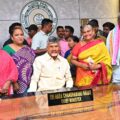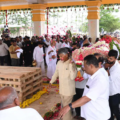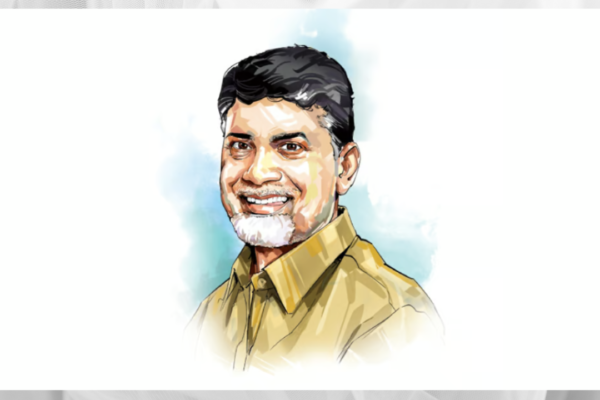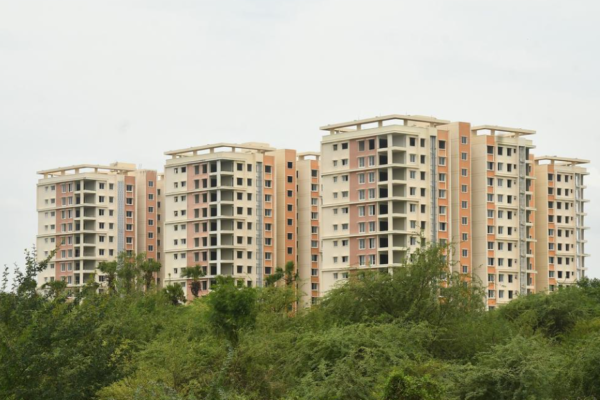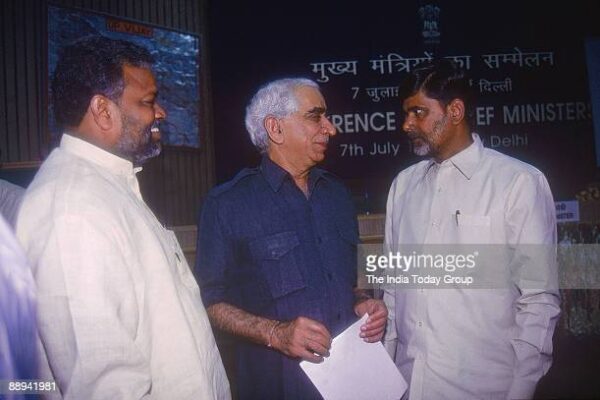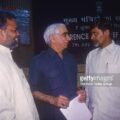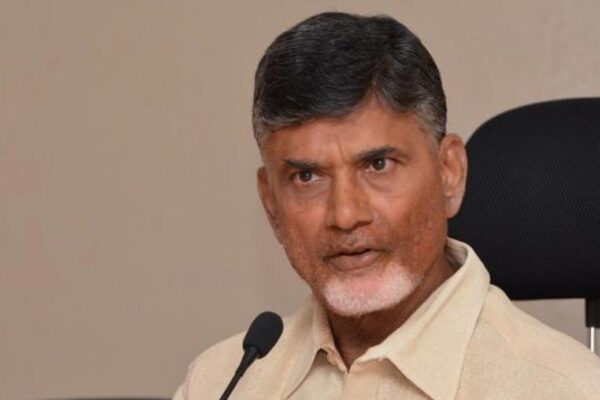
We must have political consensus on major reforms agenda cutting across party lines
Speech of Shri N. Chandrababu Naidu, Chief Minister, Andhra Pradesh at the 50th National Development Council Meeting on 21st December 2002 at New Delhi
Honourable Prime Minister, Deputy Chairman of the Planning Commission, Union Cabinet Ministers, Colleague Chief Ministers and friends. Let me at the outset compliment the Prime Minister as well as the Deputy Chairman of the Planning Commission for convening the fiftieth meeting of the National Development Council to approve the outlays and finalize the strategies for achieving the objectives and the growth targets set for the Tenth Five Year Plan (2002-2007). The planning process during the last five decades in our country has no doubt accelerated economic growth, substantially reduced poverty and improved the quality of life of our people.
Some of the achievements made by us stand out as examples for the other developing countries. Average GDP growth rate of 6.1 percent during the Eighth and Ninth Plan periods has been achieved making India one of the ten fastest growing countries in the world in spite of many impediments and structural constraints. Poverty has been substantially reduced in the country during the post reforms period from 35.97 percent in 1993-94 to 26.10 percent in 1999-2000, India’s position in the United Nations Human Development Index has been elevated to the Medium Human Development Category from 134th rank among 174 countries in 1995 to 115th rank in 2001 among 162 countries, though the position has siided to 124th rank among 173 countries during 2002.
In spite of the remarkable progress achieved in different sectors through the planning process, certain major areas of concern still remain to be addressed, which need our immediate attention at this critical juncture while formulating the strategies and setting the priorities for the Tenth Five Year Plan. Concentration of poverty in certain parts of our country has posed new challenges to our endeavour towards eradication of poverty and hunger. Containing the growth of population is yet another area of concern for all of us though the performance in this respect is highly encouraging in some parts of the country. Rapid spread of AIDS in the country particularly in certain pockets has posed the biggest challenge for all of us. Achieving total literacy and guaranteeing primary education to every child still remain as our major concerns. The recent constitutional amendment in guaranteeing primary education to every child in our country in the age group of 6 to 14 years as a fundamental right has made a beginning in the right direction. Disparities in the levels of development among states, within the states, and within the districts still persist in spite of planned development, which need to be eliminated.
The lessons learnt through the planning process in our country should form the basis for the formulation of the Tenth Five Year Plan. The gains of the planning process should be further consolidated, which have made substantial positive impacts. The potential of each state and region should be fully exploited reinforcing the latent strengths. The weaknesses should be addressed while setting new goals and priorities. The delivery system should be revamped focused on efficiency improvement.
The role of the government has to be redefined with the government playing a facilitating role for economic development and limiting itself the role to the critical sectors of growth and development. The impact of globalization and WTO free trade regime on the planning process in the country will have to taken note of while formulating our strategies for the Tenth Five Year Plan. Let me at this stage highlight some of the achievements that we have made in our state during the Ninth Five Year Plan. Rs.25150 crore was the outlay approved by the Planning Commission for the Ninth Five Year Plan and Rs.29686 crore has been the expenditure, which is 118 percent of the approved outlay.
Strengthening of core infrastructure was our priority with about 60 percent of the total expenditure on this sector. Our expenditure during the Ninth Fiver Year Plan on energy has been 29 percent, irrigation 18 percent and roads development 13 percent of the total expenditure. One fifth of the total expenditure has gone to the social sector, which was one of our key development priorities.
The average Gross State Domestic Product (GSDP) growth rate of our state has been 5.70% during Ninth Five Year Plan. The Per Capita Income has increased from Rs.11683 in 1997-98 to Rs.16562 in 2000-2001. Poverty has been reduced in our state from 22.19 percent in 1993-94 to 15.77 percent in 1999-2000. Literacy has increased from 44.08 percent in 1991 to 61.11 percent in 2001 and the special literacy campaign (Chaduvula Pandaga) implemented in the state has made a positive impact in increasing the level of literacy and school enrolment. The decadal growth rate of population has come down from 24.20% in 1981-1991 to 13.86% in 1991-2001. The achievement of the state in some of the crucial demographic indicators like infant mortality rate and total fertility rate have shown positive signs though containing AIDS has thrown the biggest challenge for us. There were certain major constraints however, which seriously affected the level of achievements in our growth targets in different sectors during the Ninth Five Year Plan.
The state had incurred irreparable loss during the Cyclone of 1997, which shattered the life and economy of the coastal region. Recurring drought had its impact on the economic growth of the state, as agriculture is the backbone of the state’s economy. Disaster management and its integration with the development process need to be focused while formulating our future strategies for the Tenth Five Year Plan. Extremist activities and factionalism in certain parts of the state have affected the development process though there has been tremendous improvement in the maintenance of law and order in the state in the recent past.
Some of the reforms initiatives undertaken at the state level during the Ninth Five Year Plan period have yielded significant results. Our approach has been to implement the reforms process with a “human face’. The state has set the trend in Public Sector Privatization in the country with 11 units already privatized and with another 23 being in the process. Revival of loss making Public Sectors Units has been a major success with units like Singareni Collieries making a turnaround from an accumulated loss of Rs.1219 crore in 1996-97 to an expected level of profit of Rs.447 crores in 2002-2003. Private Sector participation in Higher Education has set a new trend in the country with the total number of Engineering Colleges going up from 32 in 1995-96 to 217 in 2002-2003 and the number of seats increased from 8000 to 62715. The number of Medical Colleges has gone up from 10 to 21 and Dental Colleges from 2 to 12 during the same period with private sector participation. 6 Medical Colleges and 4 Dental Colleges are in the pipeline through the Private Sector participation.
There has been a rapid growth in IT Enabled Services with the city of Hyderabad achieving a growth rate of 323 percent during 2001-2002 according to the NASSCOM study, which is the highest in the country. Power Sector Reforms of our state has become a model at the national level arid the Andhra Pradesh Transmission Corporation (APTRANSCO) has been rated by CRISIL as the best rated corporation in the country.
APTRANSCO has achieved the highest score of 75 as against the lowest score of 10 in the country. The Plant Load Factor (PLF) of APTRANSCO of 86.3 percent has been the highest in the country as against the all India average of 69.9 percent. Community participation in forest management in the state has been acknowledged as a model by many external agencies. There has been an increase of 939 square kilometers in the forest cover, which is the highest in the country during 1997-1999 and one fourth of the total increase in the forest cover in the country has been in Andhra Pradesh. People’s participation in watershed management has made a substantial impact and the ground water table has increased by an average of 1.27 meters in the state through the water conservation activities undertaken under the state government initiated Neeru Meeru programme. Privatization of municipal services in Hyderabad city has been a great success with Rs.20 crore being spent on 75 percent of sanitation maintenance through privatization as against Rs.45 crores being spent on 25 percent of sanitation maintenance through municipal workers. People’s empowerment particularly empowerment of women by organizing them into Self Help Groups in the state has been a model in the country. 4.5 lakh women groups with 16 lakh members and Rs.1500 crores of group savings have set an example of sound entrepreneurship.
A new Advisory Commission has been constituted to initiate and monitor administrative reforms in the state. The National Games being held at Hyderabad has created a new spirit and pride among the youth and a time has come now to prepare ourselves for bidding for the next Olympics. The Vision 2020 of our state in January, 1999 has articulated the development goals that we want to achieve during the next two decades. Our Mission is to make Andhra Pradesh a state where poverty is totally eradicated; that every man, woman and child in the state should have access, not just to basic minimum but to all the opportunities to lead a happy and fulfilling life; and that we must emerge as a knowledge and learning society built on values of hard work, honesty, discipline and a collective sense of purpose. Our new growth agenda focuses on stimulating economic growth by concentrating on 19 primary growth engines which contribute more than 55 percent to the GSDP of the state, improving the quality of life of our people and transforming government to play a facilitating role in economic development.
The operationalisation of Vision 2020 started during the middle of the Ninth Five Year Plan and midcourse changes in the Plan priorities were undertaken within the broad framework of Vision 2020. The synergy between the Five Year Plan exercise and Vision 2020 implementation has been established with the beginning of the Tenth Five Year Plan. The’ outlay for the Tenth Five Year Plan (2002-2007) has been approved by the Planning Commission as Rs.46614 crores with 2001-2002 prices, which is an increase of 85 percent over the approved outlay of the Ninth Five Year Plan and 57 percent increase over the expenditure during the Ninth rive Year Plan. Highest priority has been accorded to social services with 29.25 percent of the outlay and 23.27 percent of the outlay has been set apart for irrigation and 15.32 percent has been earmarked for energy. Accelerating economic growth, poverty eradication, increasing productive employment, elimination of regional disparities in levels of development and improving the quality of life indices are the major goals set to be achieved during the Tenth Five Year Plan. Achieving a GSDP growth rate of 9.5 percent, Per Capita Income growth rate of 8.6 percent, population growth rate of 0.90 percent and total literacy by 2005 are the four main growth targets envisaged during the Tenth Five Year Plan apart from the key monitorable targets set by the Planning Commission. A GDP growth rate of 8 percent and the other monitorable targets set by the Planning Commission for the Tenth Five Year Plan could only be achieved provided the reform process is further accelerated jointly by the center and the states.
The strategy for the Tenth Five Year Plan needs to be formulated in the background of the new challenges and opportunities thrown up by the forces of rapid globaiization. We must have a collective vision for the nation to bring our country at par with other developed nations. Let me give here the example of the rapid strides made by China today in the world economy. India and China achieved independence almost around the same time. We adopted socialism and they adopted communism as Ideological models for development. We initiated reforms in the early nineties and they started much before us in the early eighties and today China has emerged as the fastest growing economy receiving the highest Foreign Direct Investment. Real GDP (Purchasing Power Parity Adjusted) in Billion US Dollars was 579.33 for India and 480.42 for China in 1971, which went up to 2293.65 for India and 4818.47 for China in the year 2000 and the ratio between India and China, which was 1.21 in 1971 has come down to 0.48 in the year 2000. Similarly, the real GDP Per Capita (Purchasing Power Parity Adjusted) in US Dollars was 1034.03 for India and 571.18 for China in 1971 which went up to 2257.70 for India and 3816.73 for China in 2000 and the ratio between India and China, which was 1.81 in 1971 has come down to 0.59 in 2000.
We must have political consensus on major reforms agenda cutting across party lines. We oppose reforms while in opposition and support it while in power. A strong center needs strong states. Reforms at the national level can only be expedited with greater decentralization of finance and power to the states. We must accelerate the pace of reforms and the Initiatives at the national level in this direction particularly relating to telecommunications and insurance are laudable and needs to be further accelerated. Reforms are no longer a matter of choice but have become a matter of necessity. If we look around us reform movements such as “new public management” or “reinventing government” which began in the UK and New Zealand and expanded to the US are now sweeping across the world. In an increasingly competitive world unless we reform we will be in danger of being left behind. Let me quote Michael Porter in this regard: “A nation’s wealth is [now] principally of its own collective choosing. Location, natural resources and even military might are no longer decisive. Instead, how a nation and its citizens choose to organise and manage the economy, the institutions they put in place and the type of investments they individually and collectively choose to make will determine national prosperity.”
We are a country of one billion people and we need to be bold enough in deciding our course for the future. The government can no longer remain part of the1 problem and must become part of the solution. We need to give a special thrust to wide-ranging reforms and we should draw up a clear national agenda for effecting speedy reforms focusing on creating a government that that works better and costs less. The main elements of reforms that both central and state governments should jointly address together may include the following:
i) Comprehensive reforms Reforms agenda should be drawn up jointly by the center and the states together based on broad consensus, which will include financial, legal, labour and administrative reforms.
ii) Greater decentralisation Government should be as close as possible to the governed. We have examples internationally where systematic devolution of power has been effected. The US brought out in 1996 the welfare reform law that devolved power over welfare to the States. Japan has initiated a special scheme for promoting decentralisation and in 1995 passed the Decentralisation Promotion Law, Our constitutional 73rd and 74th amendments need to be further pushed towards greater decentralization and empowerment of the people and their institutions.
iii) Privatisation of public sector enterprises We need to impart a greater vigour to our efforts for disinvesting in the public sector. A national consensus needs to be built in favour of disinvestment. Areas of open sky policy and private sector participation in tourism need to be further examined and promoted.
iv) Downsizing if the bureaucracy In country after country we are witnessing a downsizing of the bureaucracy. Some countries have had a period of public sector downsizing resulting in more than 25 percent reduction of the workforce. Despite the recommendations of our Pay Commissions we have not made much headway in downsizing government.
v) Civil service reform There is a need to clearly link employment in the civil service with performance. Moreover, it is important that we limit the expenditures .on salaries so that state finances are not adversely impacted by Government of India decisions. In 1999, Brazil passed the Camata Law which limits personnel expenditures at all levels of government to 50 percent of the current revenues at the federal level and 60 percent of the current revenues at the state and municipal levels. vi) Service to citizens Increasingly quality charters and one-stop shops are being introduced across the world for providing better services to citizens. The e-citizen approach of Singapore and Australia’s Centrelink programme have set the examples. In 1999, the Republic of Mali created one-stop investment windows for new businesses. In 1998 Ukraine through a presidential decree has reduced the need for licensing, simplified its registration procedures, limited inspection and control procedures, and established the State Committee of Ukraine on Entrepreneurship Development.
vii) Use of information technology While some of the state governments are making efforts to effectively use information technology for delivering better quality of services to citizens and businesses, the efforts on the part of Government of India need to be stepped up. It should be possible to provide all clearances for new businesses electronically, We must realise that we are in a competitive world and can be only through superior service and processes.
viii) Consistency of policy regime The Government of India had made a commitment not to tax software exports till 2009. However, the recommendation of the Kelkar Committee on Direct Taxes have raised apprehensions in the minds of investors about the stability of the Indian Tax Regime. We should ensure that we do not create such apprehensions that adversely affect investment inflows into our country
ix) Sharing of service tax All the elastic sources of revenue are with central government and the states are unable to discharge the multifarious responsibilities cast on them with their- meager financial resource base. Therefore, I strongly feel that the collection and appropriation of service tax should be left to the states.
x) Water Policy Water as a resource is extremely limited and has a serious bearing on human lives. It is suggested that the example of public-private partnership in building the Golden Quadrilateral in the roads sector should be extended to the full exploitation of irrigation potential of our river systems in the country. The Ganga-Cauvery link should be taken up in its entirety so that the surplus water available could be utilized in the areas have scarcity. Supply of drinking water to all habitations in a time bound manner could be thought of as an integral part of the new water policy, which will include water both for irrigation and for human consumption.
xi) Centrally Sponsored Schemes Let me reiterate my earlier stand that all the centrally sponsored schemes should be transferred to the states particularly those in the state list under the constitution so that the states could have the freedom to channelize the available resources towards the state specific priorities. The NDC SubCommittee on Centrally Sponsored Schemes has examined the issue in detail, however could not come to a conclusion on the real issue of transfer to the states. The new practice of the central government of transferring centrallyschemes to the states as additional central assistance In shape of grant-cumloan should be stopped forthwith and any transfer of centrally sponsored schemes to the states should be made only as grants as they were implemented by the central ministries before such transfer. The NDC today is meeting in the backdrop of the country reeling under severe drought, which has paralyzed the development process in many parts of the country including our state. Deficit of 33 and 32 percent in receipt of rainfalls during the south-west and north-east monsoons respectively, reduction of 23 and 43 percent in the crop area sown during south-west and north-east monsoons respectively have severely affected the agricultural activities in our state with its adverse impact on the lives of human and cattle population. Supply of drinking water and fodder, employment generation works and input subsidy for the farmers need to be taken up on top priority in the affected areas as immediate relief measures with greater financial assistance from the center, I would like to request the Honourable Prime Minister to appreciate the gravity of the situation and provide immediate assistance to our state and those who are severely affected due to the scourge of drought. Let us commit ourselves to strive hard to achieve the overall objectives and the growth targets set by us for the Tenth Five Year Plan and accelerate the pace of reform jointly with a strong political consensus cutting across party lines for bringing India at par with other developed nations.
THANK YOU JAI HIND JAI JANMABHOOMI
